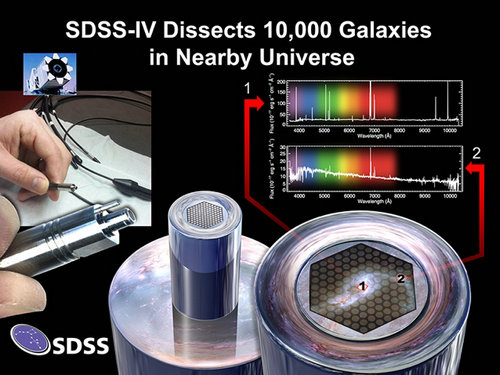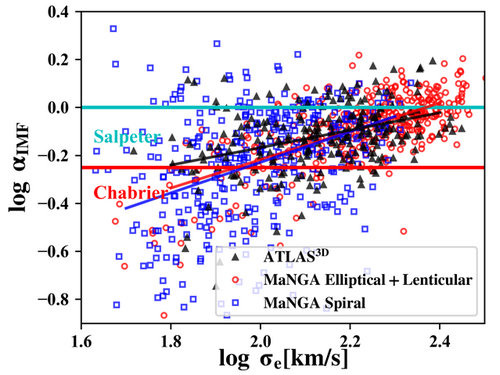The Stellar Initial Mass Function Variation in Spiral Galaxies
Researchers at the National Astronomical Observatories of Chinese Academy of Sciences (NAOC) , recently, found evidence for the stellar initial mass function variation in spiral galaxies using the data from the largest integral field unit (IFU) survey in the world. The stellar initial mass function (IMF) is a hot research topic in galaxy evolution. In a galaxy, stars with different masses are formed in giant molecular clouds simultaneously. The initial mass function describes the relative number of massive stars and low-mass stars, which plays an important role in the estimate of a galaxy’s stellar mass etc.
The best method for IMF study is by counting the number of stars with different masses in a galaxy. However, for distant galaxies, current telescopes are not powerful enough to resolve individual stars. And so other indirect methods are needed to investigate the IMF in those galaxies. Hongyu Li (a PhD student at NAOC), Junqiang Ge (assistant researcher at NAOC), Shude Mao (researcher at NAOC & professor at Tsinghua university) etc. use the data from the largest IFU survey, combining with dynamic modelling and stellar population synthesis method to investigate the IMF of 816 galaxies. This is the first time that people study the IMF of spiral galaxies using IFU data. The results have been accepted for publication in The Astrophysical Journal.
SDSS-IV MaNGA(see Fig. 1) is currently the largest IFU survey in the world. With multi-fiber bundles, astronomers can obtain many IFU spectra and kinematic information of a galaxy.

Figure 1: MaNGA IFU bundle example. Trough hexagon IFU spectra bundles, astronomers can observe the spectra of a galaxy at its different regions. The left part of the figure showsa single fiber. Thelower right panel shows how different fibers can observe different regionsof a galaxy.The upper right panel shows spectra from two different regions of a galaxy. As can be seen, the spectra in the central and outer part of a galaxy have significant differences. By analyzing these spectra, astronomers can obtain valuable information about gas/stellar kinematics and chemical information in the galaxy.

Figure 2:IMF vs. galaxy’s velocity dispersion for 816 galaxies.The red circles are MaNGA elliptical galaxies, blue squares are MaNGA spiral galaxies, black triangles are the results from the ATLAS3D survey. All galaxies in their sample are elliptical galaxies.
With IFU spectra, the galaxy’s stellar mass can be estimated using dynamical models and stellar population synthesis. The stellar mass from stellar population synthesis depends on the assumed IMF, but dynamical modelling does not. So by comparing the stellar masses from these two different methods, the IMF of a galaxy can be constrained. Fig. 2 shows the correlation between the IMF and galaxy’s velocity dispersion for 816 galaxies. The vertical axis is the ratio of the stellar mass from dynamic modelling and stellar population synthesis, which is an IMF proxy. The horizontal axis is the galaxy’s velocity dispersion, which is proportional to galaxy’s mass. As can be seen, the galaxies with higher velocity dispersion have a Salpeter-like IMF (including more low mass stars in the star formation process); while galaxies with lower velocity dispersion have a Chabrier-like IMF (fewer low mass stars). This reveals the star formation process in a galaxy can be affected by pressure, turbulence or other physical parameters. But the real cause of the IMF variation remains a mystery, yet to be solved by astronomers.
The Sloan Digital Sky Survey (SDSS) is the largest galaxy multi-filter imaging and spectra survey. The survey began in 2000. By July 2014, the image observation has covered 40% of the full sky and obtained more than one million spectra for galaxies, quasars and stars. The survey contributed significantly to the astrophysical study. The SDSS-IV began in August 2014. It is funded by more than 40 institutes, 200 astronomers around the world. The collaboration between NAOC and SDSS began in December 2012.